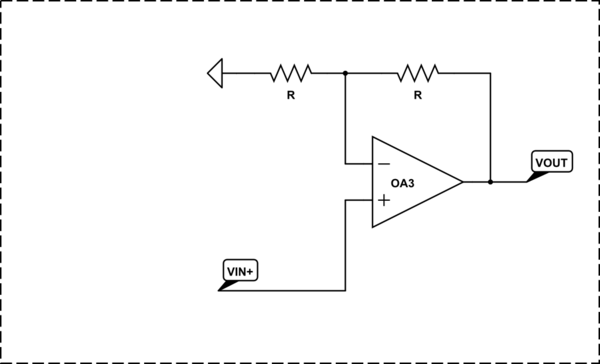Investigating basic op-amp amplifier circuits
Building the circuit structure
Step 1: Single-ended amplifier
Let's assume the two basic circuits of op-amp amplifiers with negative feedback have already been "invented":
How this happened is another (no less interesting) story, but now let's just mention the trick with which this was done - in the basic circuits of a follower (K = 1) and inverter (K = -1) an attenuation is introduced in the negative feedback. Compensating for it, they have become amplifiers.
Step 2: Imperfect "differential" amplifier
Step 3: Ordinary differential amplifier
But there is a problem - the gain of the non-inverting input is one unit higher than the gain of the inverting input (this is also interesting to explain... but let's not be now). We start looking for a way to equalize the gain of the two inputs. We have two options:
Step 4: Improved differential amplifier
But the simple 4-resistor differential amplifier has a significant drawback - low input resistance (in addition, it is different for both inputs). The worst thing in this case is that the difference in the internal resistances of the input sources unbalances the circuit.
Step 5: Instrumentation amplifier prototype
Step 6: Instrumentation amplifier
Exploring the circuit operation
The circuit operation can be visualized in an attractive way by showing the voltage distribution inside the resistors (along the resistive film). I call this picture "voltage diagram" (I have considered in detail this visualization technique in one of my Codidact papers). See also my Wikibooks story about Ohm's experiment; it is related to this paper. For this purpose, imagine the three resistors in series as a linear potentiometer with two wipers.
Differential mode
When the voltages change in the opposite direction with the same rate, the so-called "virtual ground" (zero voltage point) appears in the middle point inside Rg (as though it is connected to ground). Both non-inverting amplifiers are not really grounded; they are virtually grounded. We are beginning to realize this is a significant difference because they will interact through the common point... and this reminds us the transistor differential amplifier (“long-tailed pair”) where two transistors interact in a similar way.
So, by changing their output voltages, the op-amps try to make the voltages at their inverting inputs (wipers) equal to the voltages of the non-inverting inputs.
As a result, the middle point does not "move"... its voltage stays zero. You can "see" this "magic" virtual ground point if you "open" Rg and touch the resistive film by the voltmeter probe.
Common mode
Figuratively speaking, the op-amps "pull" the common midpoint... or move the "lever"... but now in the same direction.
Note there is no current flowing through the resistor network since the two op-amp outputs have the same voltage and there is no voltage difference across the network.
Both differential and common mode
As you can see, this mode is very similar to the fully differential mode above. The only difference is that the voltage of the middle point between resistors Rg/2 is not zero but only constant (the virtual gound is "shifted up" to the common-mode voltage).
You can see "live" voltage diagrams of these modes in the movie from my personal Google Photos. The computerized laboratory experiment shown in the movie is described in my Wikibooks story.
The circuit operation can be visualized also by showing what voltages are across resistors and where currents flow (see my SE EE answer). There I have demonstrated the opposite approach to revealing the basic idea behind the circuit - by disassembling it step by step ("reverse engineering").
The basic idea
Looking for the most essential in this beautiful symmetrical circuit solution, we can find it in the dual behavior of the midpoint inside the resistor Rg: on the one hand, in differential mode, it has a fixed voltage; on the other hand, in common mode, it follows the input voltages.
Figuratively speaking, in differential mode, it is "stiff" and immovable while, in common mode, it is "soft" and movable.












Comments
Post a Comment